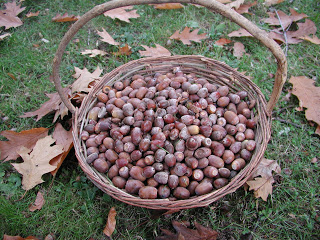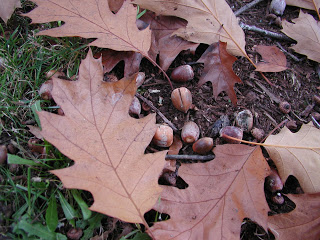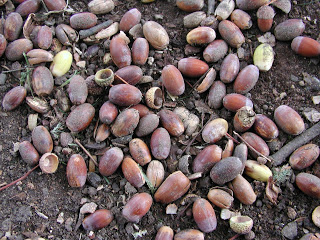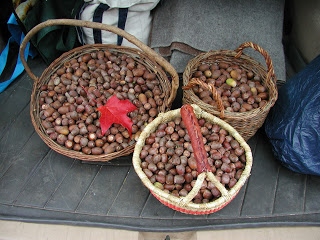One thing I love about this time of year is that food just falls from the sky…so much, in fact, that you have to be careful it doesn’t hit you on the head! All around in parks, along neighborhood streets, and at schools and college campuses, the acorns are ripe and ready for harvesting. Although people have been eating acorns for centuries, somehow they now seem to be an un-used food resource. Maybe it has to do with all the work involved. I won’t lie to you, processing acorns is a lot of work. Since I’m not one to shy away from hard work, I have to say that all those free nuts are pretty hard to pass up. They taste sweet and nutty like maple syrup, and they make an excellent alternative flour. If you’ve never tried acorn pancakes or muffins before, you’re missing out.
I look for acorns in October when the leaves are starting to litter the ground. We are fortunate here to have abundant native oaks, Quercus garryana, so forests are pretty rich in acorn resources. Having grown up in an area where we didn’t have oaks, I didn’t really see acorns until I was a young adult. They’re fascinating! When I’m walking along a sidewalk in town beneath a row of oaks, I can’t help picking up the little caps and collecting them. I often wonder how I made it through childhood with no acorn caps to play with.
The very best places I have found to gather acorns are college and university campuses. They’re so on top of coming through and cleaning up the leaves, that the acorns are left just laying out in the open for you to find. Since these oaks stay pretty well watered throughout the summers and aren’t competing with other forest plants and trees, they produce some nice, fat acorns. Plus, it’s a great conversation piece with the students walking by. They will want to know all about what you’re doing.
After you go out and fill your baskets full of acorns, the wonderful thing about them is they will just sit tight in your baskets for a while until you get some nice rainy days to process them. It’s a very low-pressure wild food. Basically, you will want to crack them with a nut cracker or a mortar and pestle, and then boil the nuts several times for about 10 minutes at a time, draining off the water to leach out the tannins. Tannins won’t kill you, but they’re very bitter and hard on your liver. Then you can either bake them into stuffing, put them in a rice pilaf, or anything else you would do with nuts. To make flour, simply dehydrate them and then put them through a grain grinder. Use the flour as you would corn or buckwheat flour in recipes, cut with lighter flours. I will go more into depth on this in a future post on processing acorns as I start my own work on it for the year.
So, my friends, now is the time to grab your baskets and go out on an acorn walk. Bring your kids along and tell them you’re pretending to be squirrels. They’ll love filling up those baskets so quickly, and watching the other squirrels scampering around with their own finds. Then you can go home and drink a cup of cocoa by the woodstove and put your feet up to worry about processing those acorns another day. That’s my kind of wildcrafting!




Yeah! Sooo awesome! When I was out in Northern Cali, I met so many folks making acorn cakes and special treats with acorn flour. They have educational days where this type of thing is taught as well. I absolutely love it!
I wanted to harvest mine, but couldn't remember the process. Thanks so much for sharing! There are a TON of them in my front yard, and more all over the property. 😀
Just stumbled upon your blog and really enjoyed the acorn post. Thanks for sharing the process, the pics and your enthusiasm for all things natural. We're getting a basket and heading to the woods to give it a try :>D
the marins,
taberg,ny
ps- we'll check out your etsy store too… looks like some cool fairies for our girls to enjoy.
This was so inspiring we started collecting them as well. Just from our front yard we have probably a pound of nuts. We're going to go nature walking this week to find more but I had a question…a lot of our nuts are black and wet this time of year in Florida. Is there any nuts we should not harvest? like cracked, black, wet, etc?
We pretended to be nature fairies harvesting our food for the winter.
Yeah for abundance! Black and wet acorns are OK as long as they aren't all funky inside. If they're cracked or have bug holes in them, I leave those behind because they're usually spoiled.
Harvest on, nature fairies!